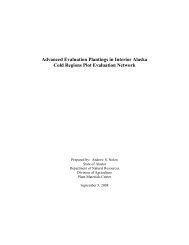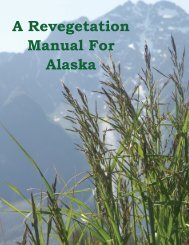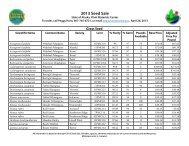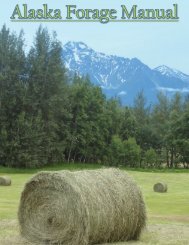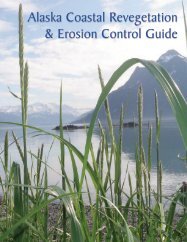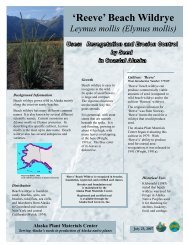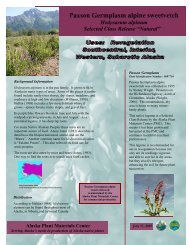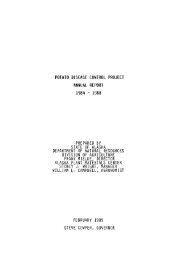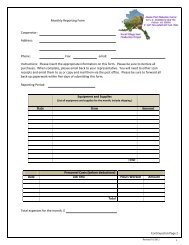Sucrose analysis and chipping ability of twenty Alaska grown potato ...
Sucrose analysis and chipping ability of twenty Alaska grown potato ...
Sucrose analysis and chipping ability of twenty Alaska grown potato ...
You also want an ePaper? Increase the reach of your titles
YUMPU automatically turns print PDFs into web optimized ePapers that Google loves.
<strong>Sucrose</strong> Analysis <strong>and</strong> Chipping Ability <strong>of</strong> Twenty <strong>Alaska</strong> Grown Potato varietiesCooperator:William L. Campbell, <strong>Alaska</strong> Plant Materials Center, Palmer, <strong>Alaska</strong>Daniel W. Bagley, 17818 N. Eagle River Loop, Eagle River, <strong>Alaska</strong> Et. Al.Location:<strong>Alaska</strong> Plant Materials Center, Palmer, <strong>Alaska</strong>Significance <strong>of</strong> Project to <strong>Alaska</strong>n Agriculture:<strong>Alaska</strong> <strong>potato</strong> growers are currently supplying 75% <strong>of</strong> the fresh market <strong>potato</strong>es sold in<strong>Alaska</strong>. <strong>Alaska</strong>n <strong>potato</strong>es are used in less than 1% <strong>of</strong> the processed <strong>potato</strong> products sold in<strong>Alaska</strong>. In the 1988 marketing season for <strong>Alaska</strong> <strong>potato</strong>es, approximately 400 tons <strong>of</strong><strong>potato</strong>es were dumped that may have been utilized for processing if reliable baseline datawere available. This project has attempted to provide an initial step in that direction.Objective:Establish baseline data on 20 <strong>potato</strong> varieties <strong>grown</strong> in <strong>Alaska</strong> <strong>and</strong> evaluate theirperformance under storage conditions that are st<strong>and</strong>ard in the processing industry. Datacorrelation was established between specific gravity, maturity(sucrose rating - SR), fry color <strong>of</strong> the 20 varieties tested. Remarkabledifferences have been demonstrated in data from <strong>Alaska</strong> <strong>grown</strong> varieties compared to similardata from the lower 48 states.Methods:Research plan was implemented to evaluate specific gravity, chemical maturity(sucrose rating - SR), fry color, fertility factors <strong>of</strong> six plots <strong>of</strong> five cooperatinggrowers <strong>and</strong> the Plant Materials Center. Twenty varieties were to be tested.An unexpected event altered the project somewhat.detected on several farms around the test plots.contamination <strong>of</strong> seed stocks at the PMC where thethe decision was made to ab<strong>and</strong>on the grower plotsthe largest plot at the PMC.Bacterial Ring Rot wasDue to the significant risk <strong>of</strong>laboratory work would be done,<strong>and</strong> continue the project usingThe plots at the Plant Materials Center were harvested September 13, 1988. Sixty poundsacks were collected <strong>of</strong> the 20 varieties <strong>and</strong> placed into a constant temperature at 600 Fstorage. Sampling began September 26, 1988 <strong>and</strong> continued every two weeks until December 3,1988.Procedure:Specific gravity - determined by using this formula: dry weight/dry weight-wet weight =specific gravityFry color - determined by cooking a .063 inch chip slice @ 375 degrees for threeminutes <strong>and</strong> matching the color to the st<strong>and</strong>ard pc/sfa chart. Temperature drop <strong>of</strong> thefryer was never below 355 °. Chip slices were taken to include the apical <strong>and</strong> basalends <strong>of</strong> the tuber. Slices were blotted dry <strong>and</strong> not washed or leached. Ten sample sliceswere tested per variety. Vegetable cooking oil was used.
SR (sucrose rating) - Van H<strong>and</strong>el method was used, as published in Ohio State UniversityResearch Bulletin #1172.200 gram samples were taken from variety samples at two week intervals beginning September26. Samples were juicerated using an Acme juicerator, placed in a zip-lock sample bag, <strong>and</strong>quickly frozen for later <strong>analysis</strong>. Later, the frozen samples were partially thawed in amicrowave, transferred to a 500 ml graduated cylinder, <strong>and</strong> volume <strong>of</strong> the sample brought to430 ml with distilled water. The mixture was placed in a flask <strong>and</strong> allowed to settle forone hour. A portion was drawn from each flask (0.1 ml) <strong>and</strong> diluted with four partsdistilled water <strong>and</strong> placed in a test tube. To each tube was added 0.1 30% KOH reagent. Eachtest tube was covered, mixed, <strong>and</strong> heated at 1000 C for 15 minutes.Three test tubes were made up with 0.1 ml sucrose reagent. <strong>Sucrose</strong> reagent is one gramsucrose diluted in 1,000 ml water. Three test tubes were made up with 0.1 ml distilledwater. Sample tubes were allowed to cool to room temperature <strong>and</strong> 3 ml Anthone reagent wasadded. Anthrone reagent is mixed by combining 76ml sulfuric acid to 30 ml distilled water, then adding .15 gram Anthrone. Test tubes wereincubated for 30 minutes at 400 C. Test tube samples were transferred to smaller 1/2 inchdiameter tubes that fit the Spectronic 20 spectrophotometer. The instrument was set to zerowith the lowest reagent blank at 620 nm. St<strong>and</strong>ard sugar solution <strong>and</strong> unknown samplesolutions were analyzed for their optical density (OD) at 620 nm in comparison to the knownsugar.Calculation to determine sucrose rating (SR):OD (unknown) x 0.1 x 107.5 (factor)/OD (st<strong>and</strong>ard) x gr. tuber = mg sucrose/gr tuber =tuber SR
<strong>Alaska</strong> <strong>grown</strong> <strong>potato</strong>es are commonly referred to as being sweet. Attempts to utilizethe commonly <strong>grown</strong> varieties 'Bakeking' <strong>and</strong> 'Green Mountain' for <strong>chipping</strong> haveresulted in an unacceptably dark colored chip. Dark chip color results from theaccumulated reducing sugars reacting with free amino acids during the frying process.This reaction called the non-enzymatic browning reaction, can be manipulated when theamount <strong>of</strong> sucrose is known.The amount <strong>of</strong> sucrose found in <strong>potato</strong>es at harvest is influenced by many factors.These factors include variety, planting date, growing location, soil fertility, wateravail<strong>ability</strong>, <strong>and</strong> any stress-inducing event. <strong>Sucrose</strong> is the major free sugar presentin all growing <strong>potato</strong> plants. It moves from the foliage to the tubers where thesucrose is channeled into cellular growth processes rather than accumulating asreducing sugars(i.e. glucose <strong>and</strong> fructose). <strong>Sucrose</strong>, being a non-reducing sugar, does not directlyaffect the non-enzyumatic reaction which causes browning. This is the reason thatimmature <strong>potato</strong>es with high sucrose levels can be chipped directly from the field.Once <strong>potato</strong>es are placed in storage, the sucrose is rapidly hydrolized into glucose<strong>and</strong> fructose which do participate in the non-enzymatic reaction. Potatoes with highsucrose levels at harvest tend to accumulate more reducing sugars <strong>and</strong> are thereforenot suitable for processing out <strong>of</strong> storage.<strong>Alaska</strong>'s short, cool growing season does not allow <strong>potato</strong> plants to physicallymature. Senescent vines <strong>and</strong> firm skins which occur in other growing areas, do notoccur in <strong>Alaska</strong>. Factors which indicate physical maturity, dead foliage, high solidscontent, tuber size, <strong>and</strong> high specific gravity, do not necessarily indicate thechemical maturity <strong>of</strong> the crop. Knowledge <strong>of</strong> the chemical maturity <strong>of</strong> the field wouldallow management decisions to be made concerning the suit<strong>ability</strong> <strong>of</strong> the crop forprocessing.A relatively simple method to determine the chemical maturity <strong>of</strong> a <strong>potato</strong> crop hasbeen developed by Dr. Joe Sowokinos working with <strong>potato</strong>es <strong>grown</strong> in the Red RiverValley. He has determined that an excellent correlation exists between sucrosecontent (SR) at harvest <strong>and</strong> the length <strong>of</strong> time in which undesirable levels <strong>of</strong>reducing sugars accumulate in intermediate temperature (50°) storage.Potatoes with a SR level below 1.5 with good chip color should retain good chip colorseven to ten months. Those with a SR level greater than 1.5 with good chip colorshould be warmed to 60-70° for two to four weeks, then held at intermediatetemperatures, should hold color four to sixmonths. Potatoes having a SR below 1.5 with poor color should be warmed to 60-70°F for two to four weeks then held at intermediate temperature. These <strong>potato</strong>es maythen chip for five to six months. Potatoes with a SRgreater than 1.5 <strong>and</strong> with poor chip color, have as their only possibility for<strong>chipping</strong> use, warming to 60-70° F for two to four weeks, then <strong>chipping</strong> immediately ifthe preconditioning works.The model developed to estimate sucrose levels <strong>and</strong> subsequent chip color wasapplied to <strong>Alaska</strong>n <strong>grown</strong> <strong>potato</strong>es. Twenty varieties were selected based onphysical maturity characteristics (early, medium, late) <strong>and</strong>/or known processingpotential.
It was believed that all varieties would have a chip color rating (CCR) <strong>of</strong> three orless, which is the desirable range <strong>of</strong> the color chart during thefirst few weeks after harvest. Varieties having a SR value greater than 1.5should have a rapid accumulation <strong>of</strong> reducing sugars which would lead to darkchip color (greater than three) within the first few weeks after harvest.The varieties '<strong>Alaska</strong> Russet', 'Campbell 13', 'Denali', 'Katahdin', 'Lemhi',"Monona', 'Norchip', 'Yukon Gold', <strong>and</strong> 'Snowchip' had sucrose levels above 1.5 atharvest. Acceptable chip color was found for all varieties except 'Lemhi' <strong>and</strong>'Green Mountain'. The remaining varieties had sucrose levels below 1.5 at harvest<strong>and</strong> acceptable chip color, except for 'Bake king', ‘Butte', <strong>and</strong> 'Russet Burbank'.The varieties '<strong>Alaska</strong> 114', 'Allagash', 'Atlantic', 'Kennebec', 'Norl<strong>and</strong>','Shepody', <strong>and</strong> 'Superior', having a low SR <strong>and</strong> good chip color at harvest, shouldhave retained their chip color for seven to ten months; however, only the variety'Allagash' retained good chip color throughout the test period. 'Superior', knownas a chipper, was the first to lose acceptable color.The project was able to determine the sucrose level, chip color <strong>and</strong> specific gravity<strong>of</strong> <strong>twenty</strong> varieties held at GO°F on a bi-weekly basis for approximately a threemonth time span. This data will assist the <strong>Alaska</strong> <strong>potato</strong> industry in gaining abetter underst<strong>and</strong>ing <strong>of</strong> the chemical maturity levels <strong>of</strong> the crop <strong>and</strong> itsrelationship to processing potential.
HARVESTDATE CHIP COLOR IS UNACCEPTABLECONDITION9/26 10/12 10/25 11/8 11/19 12/3SR AK 114 XXX XXXLESS THEN ALLAGASH1.5 ATLANTIC XXXKENNEBECXXXNORLAND XXX XXXSHEPODYXXXSUPERIOR XXX XXX XXX XXXSR AK RUSSSET XXXGREATER CAMPBELL 13 XXXTHENDENALI1.5 KATAHDIN XXX XXX XXX XXXMONONANORCHIP XXX XXX XXX XXXSNOWCHIPYUKON GOLD XXX XXX XXXSR BAKEKING XXX XXX XXX XXX XXX XXXLESS THEN BUTTE XXX XXX XXX XXX XXX XXX1.5 RUS BURBANK XXX XXX XXX XXX XXX XXXSR GREEN MTN XXX XXX XXX XXX XXX XXXGREATER LEMHI XXX XXX XXX XXX XXXTHEN1.5XXX DENOTES CHIP COLOR ABOVE 3 AND UNACCEPTABLEACCORDING TO POTATO CHIP/SNACK FOOD ASSOCIATIONCOLORCHART
REFERENCESSowokinos, J. R.; Orr, P. H.; Knoper, J. A.; Varns, J. L. 1987. Influence <strong>of</strong>Potato Storage <strong>and</strong> H<strong>and</strong>ling Stress on Sugars, Chip Quality <strong>and</strong> Integrity <strong>of</strong>the Starch (amyloplast) Membrane. American Potato Journal 64:213-226.Gould, W. A.; Plimpton, S. 1985. Quality Evaluation <strong>of</strong> Potato Cultivars forProcessing. Ohio State University Research Bulletin No. 1172.Nelson, D. C.; Sowokinos, J. R. 19'83. Yield <strong>and</strong> Relationships Among TuberSize, <strong>Sucrose</strong> <strong>and</strong> Chip Color in Six Potato Cultivars on Various HarvestDates. American Potato Journal 60:949-958.Sowokinos, J. R., Preston, D. A. 1987. Principle <strong>and</strong> Application <strong>of</strong> <strong>Sucrose</strong>Rating (SR) Analysis. Red River Valley Potato Facts, No. 100.Sowokinos, J. R. Relationship <strong>of</strong> Harvest <strong>Sucrose</strong> Content to Processing Maturity<strong>and</strong> Storage Life <strong>of</strong> Potatoes. American Potato Journal 55:333-344.



